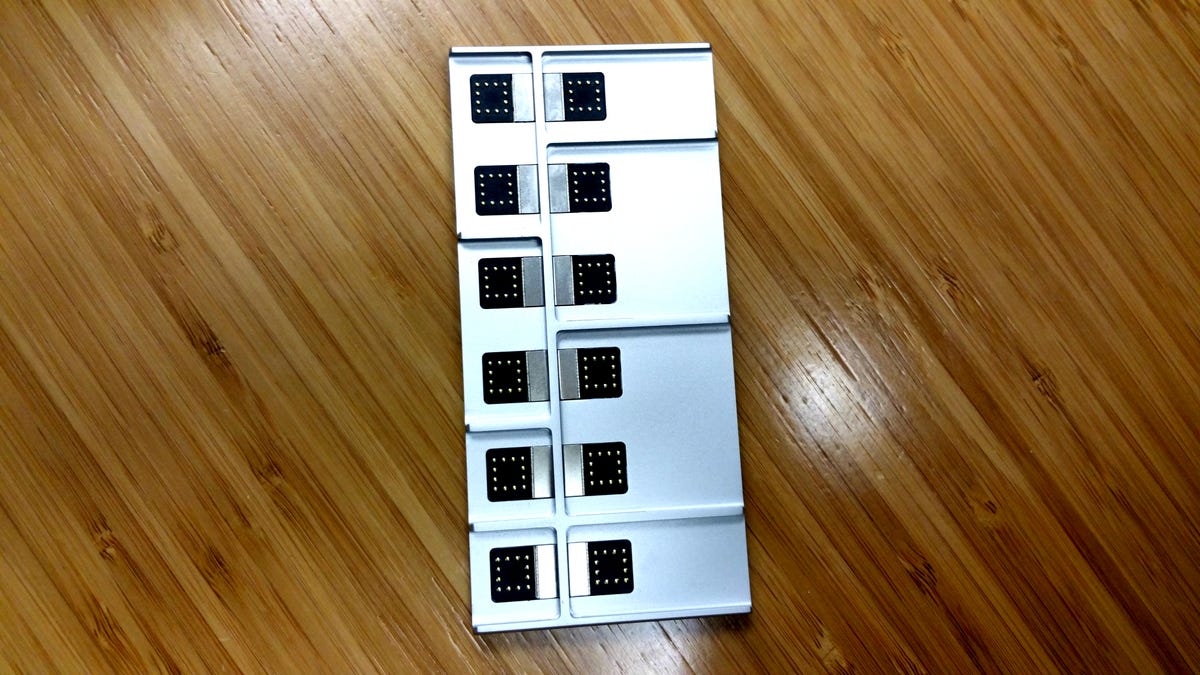
Juan Garzón/CNET
If you’ve ever wished you could pick from a pile of parts and make your own smartphone, Project Ara is your Android wish come true.
Run out of Google’s Advanced Technology and Projects group (ATAP), Ara proposes that phone owners should be able to mix-and-match components to build the phone they want to own, rather than accept whatever it is that phone makers think people want.
If you’re unfamiliar with the concept, here’s what we know so far about Google’s intriguing DIY smartphone.
What a Project Ara phone looks like
In the prototype stage so far, Ara looks like a basic rectangular frame (they call it the Endoskeleton) that’s subdivided into smaller rectangular buckets. On the back are circuit boards and contacts. It’s here that you snap in rectangular bricks for each module, say one block for an 8-megapixel camera, and another block for the processor.
You can also slide in the screen you want and add other, more specialized equipment, say a medical or gaming add-on, that’s far too niche for mainstream phones. There are different-size frames for smaller or larger handsets.
Google’s Project Ara lets you build your own phone (hands-on pictures)






We’ve seen the Spiral 2 prototype at Google’s Silicon Valley headquarters. Right now there are eight interchangeable modules. The goal is that owners will be able to put any module anywhere on the phone, so the camera can live in any square you find most convenient.
Why you care
Project Ara is the ultimate form of customization. You choose every module, pick where its placed, select the color and visual design. That brings tremendous flexibility to phone owners, both in terms of getting the specs they want, and in terms of cost.
Related stories
- Google launching Project Ara pilot in Puerto Rico
- Yezz tapped as Project Ara module-maker
- PuzzlePhone is an open-source Project Ara challenger
Higher-end parts will cost more, but for those shopping on a budget, picking the specs you want will also give you your choice of what you spend your money on, and where you save. Maybe you like a high-resolution screen, but you aren’t much of a shutterbug. That could potentially save you money over a phone with all-around high-end parts.
One of the most exciting possibilities with an Ara phone is swapping in specialized components, say a mini telephoto lens, or a heart-rate monitor. The temporary nature of these interchangeable parts means you could pack in different modules for different activities.
Project Ara’s modular nature also means you can upgrade on your own schedule, which can benefit early adopters as well as people who hold onto their technology longer. Ara could be cheaper in the long run if you keep the same body and only swap certain parts, or it could fast-track you to the latest and greatest processor or camera if you’re hot to get the next best thing as soon as it arrives.
When it’s launching
Google announced in January that it’ll launch a Project Ara pilot program in Puerto Rico later in 2015, though we don’t have exact dates, or even much of a time frame. Google has signed two carrier partners for the launch, Claro and Open Mobile.
Paul Eremenko, who heads Project Ara, said Puerto Rico is a good choice for its tremendous volume of Internet traffic on mobile phones: 75 percent. The country also has the right blend of smartphone and feature-phone owners, Eremenko said.
Who’s involved
So far, Toshiba and Miami-based phone maker Yezz have publicly said they’re building parts. Toshiba has developed two processors (PDF) for Ara phones and has created a camera module for Project Ara. In this case, it’s a 5-megapixel unit (see video below).
For its part, Yezz has been tapped to create the modules themselves. That doesn’t mean the company is only making the housing; some modules will be more basic, while others will “have a little bit more of the imagination that modular architecture inspires.” Yezz won’t tell us much more than that for a few more weeks.
Yezz won’t be the only company involved, but it will help create the 20 or 30 modules that Google hopes to ready by the pilot launch.
Google is a major player, not just for running the show, but also because it’ll own the online marketplace where owners of Project Ara phones can buy modules, a huge revenue opportunity for the company if these mix-and-match phones take off.
How much an Ara phone will cost
The price tag on an Ara phone will depend on a lot of things, like how big it is and the cost of the parts you choose. Also, carriers will have their own pricing if they sell you an Ara-phone package.
That said, Project Ara’s FAQ does say this:
We have set engineering and manufacturing goals for the bill-of-materials cost of a basic, entry-level Ara device to be in the $50-100 range. It’s important to note that this is just the cost of the components and says nothing about how it will be priced–it could be more or less than that (e.g., with a carrier contract). In the end, we expect that module developers will be able to set the prices for their modules sold in the Ara Module Marketplace, much like mobile app developers do in app stores today.
There is some concern that by the time you’re done, the phone could wind up costing more than a typical handset with the same specs, depending on carrier deals and sales.
Potential drawbacks
Prototype devices don’t always wind up looking like the finished product, but there are already a few questions I have, especially when it comes to battery life and efficiency.
Ara’s team has said that it’s working on stretching the battery life of its Spiral prototype family to a full day, at least by the time of Project Ara’s global rollout. The battery is just one other module, which is good (because you can supersize) and bad (because the batteries could be less efficient). Team Ara plans to handle this challenge by letting you hot-swap a bunch of power supplies (like solar arrays and mini fuel cells in addition to your battery packs) without powering down your device. The catch: for extra-long battery life you still have to buy those additional modules in the first place.


Now playing:
Watch this:
What you need to know about Project Ara
1:35
I also wonder if there will be any missteps in the way that components cooperate when you swap them out. Usually, a layer of software helps them communicate. If Ara phones run the basic Android software, there may not be a problem (phones typically use parts made by a number of companies anyway). If the handset were to use a variation of Android, that could be a different story.
A spokesperson for Project Ara told CNET that the Module Developers Kit (MDK) is designed to communicate with both the Endoskeleton and any other inserted module. A forthcoming Ara Application Manager should handle the handoff between two modules that do roughly the same thing; two camera blocks, for instance.
Then there’s the question of compatibility. A weak processor and very high-end camera won’t go together. Some requirements or at least tips might help Ara users avoid mishaps. The Google group hasn’t figured this out yet, but plans to help nudge customers to better combinations and steer clear of bad pairings.


Juan Garzón / CNET
Durability and waterproofing could also take a hit from the open, snap-on design. In the event that something does go wrong, you’d have to reach out to each module maker in particular, or swap out the broken part. There’s less of a safety net with a broken Ara phone, but also potentially a faster resolution if you replace the part yourself, as with a bashed screen.
Project Ara says that with its pilot in Puerto Rico, Google will lean on “third-party logistics partners” to help process issues like warranties and replacements.
Not for everyone
A concept in development, Project Ara’s modular phones aren’t meant to replace your conventional, all-in-one phone anytime soon. As with Android fans, Ara will appeal to tinkerers who like to control their specs and bonus hardware, not to those who prefer simpler solutions.
When we’ll know more
Phone maker Yezz will show off some of its modules at Mobile World Congress in Barcelona the first week in March. Other than that, we’ll keep our ears and eyes open for more support from hardware makers and from Google itself. We’re also hoping to see the Spiral 3 prototype that the team says is already under way.
Article updated at 3:35 p.m. PT with a quote from Yezz and at 5:30pm with comment from Google’s Project Ara. Updated on February 19 at 6:55am to correct “Exoskeleton” to “Endoskeleton”.



